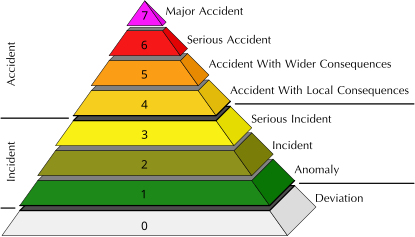Japan
on 21-08-2013 (Wednesday) has raised the alert from level one which indicates
an anomaly.It was done following 300 tonnes of radioactive water leak from a
tank in crippled Fukushima Plant.
What is INES and the alert levels?
What is INES and the alert levels?
The International Nuclear and Radiological Event Scale (INES) was
introduced in 1990 by the International Atomic Energy Agency (IAEA) in order to enable prompt communication of safety-significant
information in case of nuclear accidents.
The scale is intended to be logarithmic,
each increasing level represents an accident approximately ten times more
severe than the previous level.
There are seven nonzero levels on the INES
scale: three incident-levels and four accident-levels. There is also a level 0.

Level 7: Major accident
Major release of radioactive material
with widespread health and environmental effects requiring implementation of
planned and extended –countermeasures. There have been two such events
to date
Chernobyl disaster, 26 April 1986.
Fukushima Daiichi nuclear disaster, a series of
events beginning on 11 March 2011.
Level 6: Serious accident
Impact on people and environment
Significant release of radioactive material likely to
require implementation of planned countermeasures.
There has been only one such event to date:
Level 5: Accident with wider consequences
Impact on people and environment
Limited release of radioactive material likely to require implementation
of some planned countermeasures.
Several deaths from radiation.
Impact on radiological barriers and
control
Severe damage to reactor core.
Release of large quantities of radioactive material within
an installation with a high probability of significant public exposure. This
could arise from a major criticality accident or fire.
Examples:
Windscale
fire (United Kingdom), 10
October 1957
First Chalk River accident,[9][10] Chalk River, Ontario (Canada), 12 December 1952.
Level 4: Accident with local consequences
Impact on people and environment
Minor release of radioactive material unlikely to result in
implementation of planned countermeasures other than local food controls.
At least one death from radiation.
Impact on radiological barriers and
control
Fuel melt or damage to fuel resulting in more than 0.1%
release of core inventory.
Release of significant quantities of radioactive material
within an installation with a high probability of significant public exposure.
Examples:
Sellafield (United Kingdom) –
five incidents 1955 to 1979
Tokaimura nuclear accident (Japan) – 1999
Level 3: Serious incident
Impact on people and environment
Exposure in excess of ten times the statutory annual limit
for workers.
Non-lethal deterministic health effect (e.g., burns) from
radiation.
Impact on radiological barriers and
control
Exposure rates of more than 1 Sv/h in an operating area.
Severe contamination in an area not expected by design, with
a low probability of significant public exposure.
Impact on defence-in-depth
Near accident at a nuclear power plant with no safety
provisions remaining.
Lost or stolen highly radioactive sealed source.
Misdelivered highly radioactive sealed source without
adequate procedures in place to handle it.
Examples:
Paks Nuclear Power Plant (Hungary), 2003;
San Onofre Nuclear Generating Station (United States), 2011
Level 2: Incident
Impact on people and environment
Exposure of a member of the public in excess of 10 mSv.
Exposure of a worker in excess of the statutory annual
limits.
Impact on radiological barriers and
control
Radiation levels in an operating area of more than 50 mSv/h.
Significant contamination within the facility into an area
not expected by design.
Impact on defence-in-depth
Significant failures in safety provisions but with no
actual consequences.
Found highly radioactive sealed orphan source, device or
transport package with safety provisions intact.
Inadequate packaging of a highly radioactive sealed source.
Examples:
·
Blayais
Nuclear Power Plant flood (France) December 1999
Shika Nuclear Power Plant (Japan) 1999
Level 1: Anomaly
Impact on defence-in-depth
Overexposure of a member of the public in excess of
statutory annual limits.
Minor problems with safety components with significant
defence-in-depth remaining.
Low activity lost or stolen radioactive source, device or
transport package.
(Arrangements for reporting minor
events to the public differ from country to country. It is difficult to ensure
precise consistency in rating events between INES Level-1 and Below
scale/Level-0)
Examples:
Level 0: Deviation
No safety significance.
Examples:
17 December 2006, Atucha, Argentina: Reactor shutdown due to tritium increase in reactor compartment
No comments:
Post a Comment